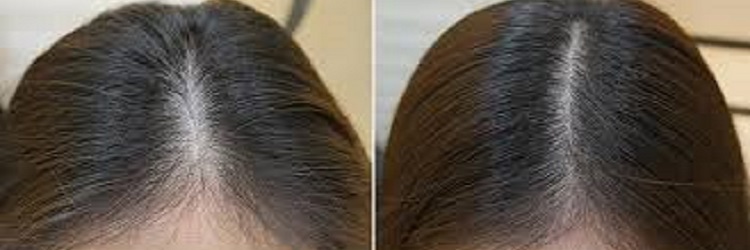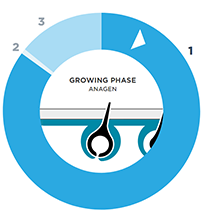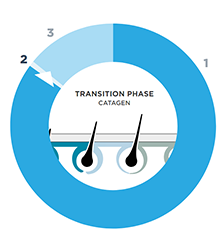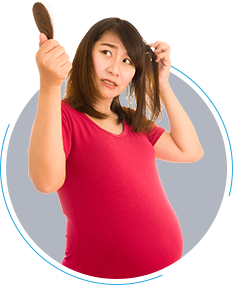At 20 weeks, a human foetus would have developed around 5 million hair follicles on its body, with a million of them residing on the head. Fun Fact: After this stage, we do not generate any new hair follicles – making this the maximum number on our scalp during the course of our lifetime! As we grow, our scalp expands as well, resulting in a decreasing scalp-hair density. Fast-forward to 20 years, and suddenly we’re experiencing hair thinning and hair loss – unannounced and prematurely!
So what or who’s to blame? Losing hair is part of the natural cycle of hair growth and hair shedding. Each hair strand goes through a normal growth cycle, with scalp hair growing about 6 inches annually. Since human hair shedding is not seasonal, any percentage of hair would be in 1 of the 3 stages of hair growth at a given time:
Anagen – Active Phase
This is the active phase where new hair is formed and old hair which has stopped growing is pushed out of the follicle. The Anagen phase lasts for about 2 to 6 years, where a hair strand grows around 1 cm every 28 days. The length of our hair depends on whether one has a short active phase of hair growth or a longer hair growth phase.
Catagen – Degradation Phase
Around 3% of hair is in the transitional stage which has a duration of about 2 to 3 weeks. Hair growth stops and the outer root covering contracts & attaches to the root of the hair – forming what is also called a club hair, wherein blood supply and new cell formation gets blocked.
Telogen – Resting Phase

However, when hair does not grow back, it leads to thinning hair and we notice a more visible scalp. There are a range of factors including heredity, hormonal imbalances, nutritional deficiencies, medication, high-stress, trauma, diseases, illness or scalp infections that can affect normal hair growth and shedding cycles, causing a higher number of hair strands to shed, resulting in either temporary or permanent hair loss.
Androgens (testosterone, dihydrotestosterone) control human hair growth as well as play a key role in hereditary hair loss. Male-female pattern baldness (androgenetic alopecia) is caused by hair follicles with higher sensitivity to dihydrotestosterone (DHT). Hair production slows down, and the new hair grows weaker and shorter, eventually halting its growth.
If you’re experiencing premature hair thinning, it’s essential to diagnose the cause, whether it’s heredity, an underlying health issue, stress or poor lifestyle habits. Consciously making the effort to incorporate healthier changes will definitely show results, since many factors for hair fall are directly related to the lifestyle we lead.
Hormonal Imbalances
Hormones are the little chemical messengers of our body – and hormonal fluctuations can have the ability to affect hair growth. Oestrogen is the key hormone in women. It keeps hair in the growth phase for a longer duration and improves the texture and quality of hair – when oestrogen levels are in balance, that is. Too much oestrogen can lead to hair thinning and hair loss.
Testosterone is a predominantly male hormone that is produced in small quantities in women’s bodies. While levels of testosterone are generally subdued in women, the effects of this hormone can be seen when women’s oestrogen levels fall (like after pregnancy, for example) resulting in female pattern baldness.
Nutrition
To prevent early hair-thinning, include a diet rich in proteins, vitamins B3, B5, B9, E, zinc, magnesium and iron. Oranges, bananas, milk, dairy, wheat, oats, fortified cereals, spinach, leafy greens, broccoli, beans, soya beans, almonds, cashews, chicken, egg yolk & fish are all excellent sources of healthy hair nutrients which help suppress dihydrotestosterone.
Don’t forget to drink for hair health. Not drinking enough water can hinder your natural hair growth cycle. Water supplies essential nutrients, removes waste and hydrates your hair follicles to support cell reproduction and boost hair growth, making it the best (and cheapest) hair tonic for luscious locks!
Stress
Coenzyme Q10 supports the scalp’s ability to produce energy for healthy cell function. The biggest culprit of accelerated hair fall is stress which causes oxidation, thus damaging Coenzyme Q10. Ensure at least 7-8 hours of sleep daily and regular exercise. It’s important to manage your stress, especially in today’s relentless time and age.
Smoking & Alcohol
Smoking and alcohol are not your hair’s best friend. Oxygen is essential for hair health. Smoking decreases the oxygen level in your bloodstream, carbon monoxide damages hair follicles while nicotine constricts blood flow which leads to unhealthy hair. It’s advisable to quit smoking especially if you’re suffering from excessive hair fall.
Alcohol siphons off the body’s iron supply, blocking zinc absorption. Dehydration from alcohol also thwarts the absorption of hair nutrients leaving hair brittle. It’s not an issue for occasional drinkers, but for pub regulars, it’s wiser to put down the peg.
Hair Styling Products
Constantly subjecting your hair to styling procedures can make your strands brittle and weak leading to breakage over time. Permanent hair solutions, tight hairstyles and chemical hair products like dyes or bleaches can damage your hair follicles causing hair loss. If that’s the case, it’s time to give your hair a rest.
Premature hair thinning is a serious matter, and it’s best to address it at its roots and act upon it right away. Additionally, a hair-transplant is another option for persistent and irreversible hair loss. To know more about hair thinning, its causes and the right treatment to combat your problem, book an appointment with a reputed dermatologist or trichologist by signing up on www.skinandhairacademy.in.




















